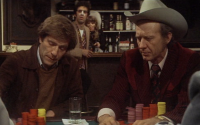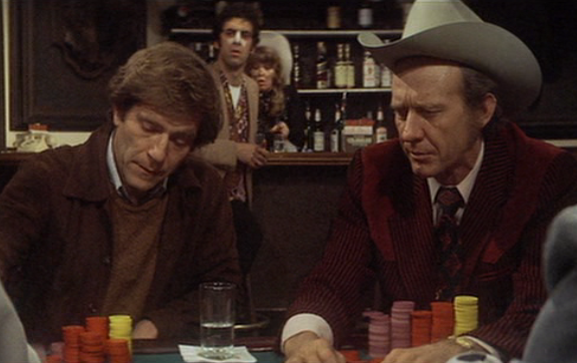 Thomas “Amarillo Slim” Preston died this past weekend. He was 83 years old.
Thomas “Amarillo Slim” Preston died this past weekend. He was 83 years old.
Though scandal clouded his reputation during his later years, Slim is still best remembered as the champion of the 1972 WSOP Main Event. Quite opposite in demeanor from the event’s only previous champion, the legendary Johnny Moss, Slim used the win as a springboard to the pop-culture limelight. He appeared on the Tonight Show, Good Morning America, and numerous game shows, and his larger-than-life personality and effortless charm won over TV hosts like Johnny Carson. Slim’s PR tour was one of the very first steps on the long road of popularizing – and thus legitimizing – the game of poker in an era of mass communications.
On TV, Slim played the role of pitchman, using his personality to sell the game of poker to a potential ocean full of fish. As historical curiosities those appearances are great, but they are lacking when it comes to allowing the audience to see a poker legend in his natural environment. Luckily for those of us who care about poker’s history, Amarillo Slim was popular enough at the time to be asked to play a part in legendary director Robert Altman’s 1974 film California Split. Even more luckily, poker’s first pitchman was constitutionally incapable of saying anything but “yes” to such an opportunity.
Nearly 40 years after its release, the film is still a great watch. It follows the exploits of a full-time hustler and a degenerate gambler writer, played by Elliott Gould and George Segal, who wager their money in nearly every conceivable way during the film’s 108-minute runtime. They shoot dice, they play the horses, but more than anything else they play poker. In a lot of ways the film serves today as a time capsule. Its settings – the card rooms of Gardena where limit Draw was the big game, the horse tracks where the Sport of Kings hadn’t yet begun its long, slow decline – have forever faded into history, and the people who were there are beginning to leave us as well.
The majority of the action takes place in California, but toward the end of the film Gould and Segal, fed up with the roller-coaster ride and ready to end it one way or another, head to Reno. After a big (and unlikely) winning streak in the casino, Segal decides to take his shot and sit in a big cash game. As Segal and Gould walk into the room and sit at the bar they begin scoping out the competitors in the game. They can pin down exactly what types of players they’re dealing with, but when they come to an empty seat it’s all speculation. “Who could tell?” Gould says. “Very tall stack of chips, it’s a little impressive.”
The seat’s absent occupant arrives on the scene moments after Segal is called over to the game – and lo and behold, it’s Amarillo Slim. He’s completely decked out in his Texas cowboy hustler uniform, Stetson perched atop his head and ostrich-skin boots on his feet, red suit jacket with black pinstripes draped over his lanky frame. His dark hair is just beginning to gray at the ends, and his sideburns reach down below his ears. Slim’s air is smooth and confident; he looks like the kind of man whose gambling knowledge is vast, earned through hard experience, and liable to end up expressed in homespun colloquialisms.
Talking with the bartender, Slim pulls an enormous stack of $100 bills from his jacket, probably worth upward of $10,000, and asks her to put some bets for him on a horse at Santa Anita. (“Ol’ Blue out of chute number two!”) Gould, who’s sitting nearby at the bar while Segal plays their money in the poker game, raises his eyebrows and shakes his head in disbelief. Then he asks Slim if the tip on the horse is reliable, saying he might put “get a taste of that” himself. Slim lights up at this, sensing that Gould may be a man with money to burn. “You want to risk it in that poker game?” he asks Gould, nodding toward the table with an easy smile. Gould tells him he’s already in the game, having part of his partner’s action; Slim promises him, “I won’t play at you too hard.”
Remarkably, watching him in action for the few minutes he’s on-screen, it never feels like Slim’s acting. Part of that can be attributed to Altman’s naturalistic style of filmmaking. But even with that taken into consideration, it’s easy to see that Slim is the perfect man for the part. His entire mode of functioning in his natural environment is an act: his constant, almost subconscious, scanning of the crowd for a sucker; his familiarity with the staff in the poker room; his nonchalance with enormous sums of cash money. But beyond that, he is a poker player. The spark in his eye when he thinks Gould might be an easy mark is a telltale sign of the sense that enabled him to make a living in back-room poker games all across Texas back in the old days.
For the viewer, getting the chance to see that look, and the dance he engages in with Gould, without losing a large sum of money directly afterward is akin a gazelle getting the chance to walk past a sleeping lion. Given that this particular lion has now moved on to the great savanna in the sky, this scene is now nothing less than a priceless historical relic.






